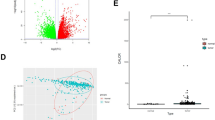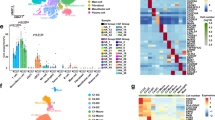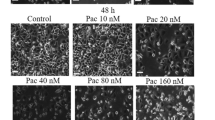Abstract
NPS-2143 is a calcium-sensing receptor (CaSR) antagonist that has been demonstrated to possess anticancer activity. To date, the effects of NPS-2143 on gastric cancer (GC) cell growth, motility, and apoptosis have not been investigated. In the present study, we firstly investigated the expression of CaSR in GC tissues using immunohistochemistry and western blotting. Then Cell Counting Kit-8 and colony formation assays were conducted to explore the effect of the NPS-2143 on the proliferation of GC cell line AGS. Transwell invasion and migration assays were performed to test the effect of NPS-2143 on AGS cell motility. We determined the percentage of apoptotic cells by flow cytometry and explored the changes of apoptosis-related protein by western blotting. Furthermore, we constructed a CaSR knockdown AGS cell line to determine whether NPS-2143 acted via inhibition of CaSR. We found that the protein expression level of CaSR was higher in GC tissues compared with the paired adjacent normal tissues. In addition, NPS-2143 treatment caused an inhibitory effect on the proliferation, invasion, and migration of AGS cells and a promoting effect on AGS apoptosis. The expression of Bcl-2 was decreased while the levels of Bax and active caspase 3 were enhanced in AGS cells after NPS-2143 treatment. Mechanistically, NPS-2143 lead to a significant decrease in the expression of phosphorylated (p)-AKT, phosphorylated mechanistic target of rapamycin (p-mTOR), p70, and cyclin D1. Knockdown of CaSR also suppressed cell proliferation, invasion, and migration and promoted cell apoptosis. No significant difference was observed between CaSR-silenced AGS cells with and without NPS-2143 treatment. These results confirmed that NPS-2143 has an inhibitory influence on AGS cell growth via inhibiting CaSR, which then suppresses the PI3K/Akt signaling pathway.
This is a preview of subscription content, access via your institution
Access options
Subscribe to this journal
Receive 12 print issues and online access
$259.00 per year
only $21.58 per issue
Buy this article
- Purchase on SpringerLink
- Instant access to full article PDF
Prices may be subject to local taxes which are calculated during checkout







Similar content being viewed by others
References
Torre LA, Bray F, Siegel RL, Ferlay J, Lortet-Tieulent J, Jemal A. Global cancer statistics, 2012. Cancer J Clin. 2015;65:87–108.
Panani AD. Cytogenetic and molecular aspects of gastric cancer: clinical implications. Cancer Lett. 2008;266:99–115.
Lin MT, Lin BR, Chang CC, Chu CY, Su HJ, Chen ST, et al. IL-6 induces AGS gastric cancer cell invasion via activation of the c-Src/RhoA/ROCK signaling pathway. Int J Cancer. 2007;120:2600–8.
Gan J, Ke X, Jiang J, Dong H, Yao Z, Lin Y, et al. Growth hormone-releasing hormone receptor antagonists inhibit human gastric cancer through downregulation of PAK1-STAT3/NF-kappaB signaling. Proc Natl Acad Sci USA. 2016;113:14745–50.
Van CE, Sagaert X, Topal B, Haustermans K, Prenen H. Gastric cancer. Lancet. 2016;388:2654.
Cifuentes M, Fuentes C, Mattar P, Tobar N, Hugo E, Ben-Jonathan N, et al. Obesity-associated proinflammatory cytokines increase calcium sensing receptor (CaSR) protein expression in primary human adipocytes and LS14 human adipose cell line. Arch Biochem Biophys. 2010;500:151–6.
Brown EM, Pollak M, Hebert SC. Sensing of extracellular Ca2+ by parathyroid and kidney cells: cloning and characterization of an extracellular Ca(2+)-sensing receptor. Am J Kidney Dis. 1995;25:506–13.
Ward DT, Riccardi D. New concepts in calcium-sensing receptor pharmacology and signalling. Br J Pharmacol. 2012;165:35–48.
Tennakoon S, Aggarwal A, Kallay E. The calcium-sensing receptor and the hallmarks of cancer. Biochim Biophys Acta. 2016;1863:1398–407.
Chakravarti B, Dwivedi SK, Mithal A, Chattopadhyay N. Calcium-sensing receptor in cancer: good cop or bad cop? Endocrine. 2009;35:271–84.
Corbetta S, Mantovani G, Lania A, Borgato S, Vicentini L, Beretta E, et al. Calcium-sensing receptor expression and signalling in human parathyroid adenomas and primary hyperplasia. Clin Endocrinol. 2000;52:339–48.
Bhagavathula N, Hanosh AW, Nerusu KC, Appelman H, Chakrabarty S, Varani J. Regulation of E-cadherin and beta-catenin by Ca2+ in colon carcinoma is dependent on calcium-sensing receptor expression and function. Int J Cancer. 2007;121:1455–62.
Brennan SC, Thiem U, Roth S, Aggarwal A, Fetahu I, Tennakoon S, et al. Calcium sensing receptor signalling in physiology and cancer. Biochim Biophys Acta. 2013;1833:1732–44.
Tae CH, Shim KN, Kim HI, Joo YH, Lee JH, Cho MS, et al. Significance of calcium-sensing receptor expression in gastric cancer. Scand J Gastroenterol. 2016;51:67–72.
Xie R, Xu J, Xiao Y, Wu J, Wan H, Tang B, et al. Calcium promotes human gastric cancer via a novel coupling of calcium-sensing receptor and TRPV4 channel. Cancer Res. 2017;77:6499–512.
Lee JW, Park HA, Kwon OK, Park JW, Lee G, Lee HJ, et al. NPS 2143, a selective calcium-sensing receptor antagonist inhibits lipopolysaccharide-induced pulmonary inflammation. Mol Immunol. 2017;90:150–7.
Lee JW, Park JW, Kwon OK, Lee HJ, Jeong HG, Kim JH, et al. NPS2143 inhibits MUC5AC and proinflammatory mediators in cigarette smoke extract (CSE)-stimulated human airway epithelial cells. Inflammation. 2017;40:184–94.
Yarova PL, Stewart AL, Sathish V, Britt RD Jr., Thompson MA, et al. Calcium-sensing receptor antagonists abrogate airway hyperresponsiveness and inflammation in allergic asthma. Sci Transl Med. 2015;7:284ra60.
Joeckel E, Haber T, Prawitt D, Junker K, Hampel C, Thuroff JW, et al. High calcium concentration in bones promotes bone metastasis in renal cell carcinomas expressing calcium-sensing receptor. Mol Cancer. 2014;13:42.
Yamamura A, Ohara N, Tsukamoto K. Inhibition of excessive cell proliferation by calcilytics in idiopathic pulmonary arterial hypertension. PLoS ONE. 2015;10:e0138384.
Wang S, Qiu L, Song H, Dang N. NPS - 2143 (hydrochloride) inhibits melanoma cancer cell proliferation and induces autophagy and apoptosis. Med Sci. 2018;34:87–93.
Yamamura A, Nayeem MJ, Sato M. Calcilytics inhibit the proliferation and migration of human prostate cancer PC-3 cells. J Pharmacol Sci. 2019;139:254–7.
Choi JS, Shin S, Jin YH, Yim H, Koo KT, Chun KH, et al. Cyclin-dependent protein kinase 2 activity is required for mitochondrial translocation of Bax and disruption of mitochondrial transmembrane potential during etoposide-induced apoptosis. Apoptosis Int J Progr Cell Death. 2007;12:1229.
Darvin P, Baeg SJ, Joung YH, Sp N, Kang DY, Byun HJ, et al. Tannic acid inhibits the Jak2/STAT3 pathway and induces G1/S arrest and mitochondrial apoptosis in YD-38 gingival cancer cells. Int J Oncol. 2015;47:1111–20.
Chang L, Graham PH, Ni J, Hao J, Bucci J, Cozzi PJ, et al. Targeting PI3K/Akt/mTOR signaling pathway in the treatment of prostate cancer radioresistance. Crit Rev Oncol Hematol. 2015;96:507–17.
Polivka J Jr., Janku F. Molecular targets for cancer therapy in the PI3K/AKT/mTOR pathway. Pharm Ther. 2014;142:164–75.
Li HX, Kong FJ, Bai SZ, He W, Xing WJ, Xi YH, et al. Involvement of calcium-sensing receptor in oxLDL-induced MMP-2 production in vascular smooth muscle cells via PI3K/Akt pathway. Mol Cell Biochem. 2012;362:115–22.
Guang-Wei L, Miao HZ, Bo L, Shen YH, Qiu LP, Zhang YZ, et al. Calcium-sensing receptor mediates hypoxia-induced proliferation of A549 cells through PI3K/AKT pathway. Chin J Pathophysiol. 2017;33:505–9.
Acknowledgements
Z-LZ and S-RW designed this work. Z-LZ, Z-RL and J-SL carried out the experiments. Z-RL prepared the figures. Z-LZ wrote the manuscript and analyzed the results. S-RW helped explain the results and revised the manuscript.
Author information
Authors and Affiliations
Corresponding author
Ethics declarations
Conflict of interest
The authors declare that they have no conflict of interest.
Additional information
Publisher’s note: Springer Nature remains neutral with regard to jurisdictional claims in published maps and institutional affiliations.
Rights and permissions
About this article
Cite this article
Zhang, ZL., Li, ZR., Li, JS. et al. Calcium-sensing receptor antagonist NPS-2143 suppresses proliferation and invasion of gastric cancer cells. Cancer Gene Ther 27, 548–557 (2020). https://doi.org/10.1038/s41417-019-0128-4
Received:
Revised:
Accepted:
Published:
Issue date:
DOI: https://doi.org/10.1038/s41417-019-0128-4
This article is cited by
-
Amlodipine inhibits Synaptotagmin-4’s oncogenic activity on gastric cancer proliferation by targeting calcium signaling
Functional & Integrative Genomics (2024)
-
Calcium sensing receptor stimulates breast cancer cell migration via the Gβγ-AKT-mTORC2 signaling pathway
Journal of Cell Communication and Signaling (2022)
-
Calcium-sensing receptor bridges calcium and telomerase reverse transcriptase in gastric cancers via Akt
Clinical and Translational Oncology (2020)



